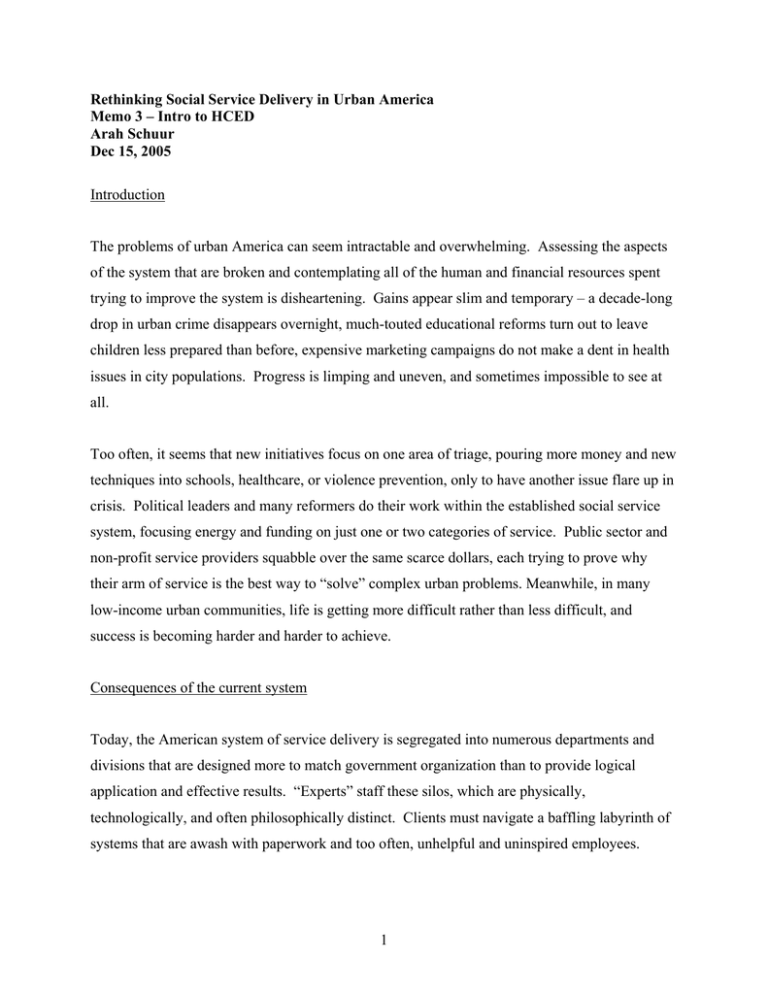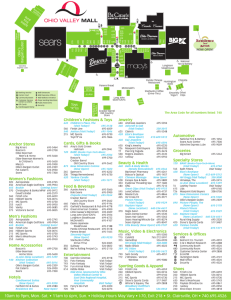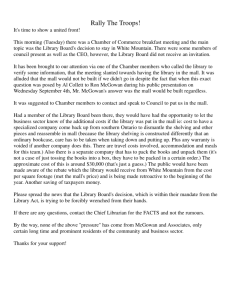Rethinking Social Service Delivery in Urban America Arah Schuur Dec 15, 2005
advertisement

Rethinking Social Service Delivery in Urban America Memo 3 – Intro to HCED Arah Schuur Dec 15, 2005 Introduction The problems of urban America can seem intractable and overwhelming. Assessing the aspects of the system that are broken and contemplating all of the human and financial resources spent trying to improve the system is disheartening. Gains appear slim and temporary – a decade-long drop in urban crime disappears overnight, much-touted educational reforms turn out to leave children less prepared than before, expensive marketing campaigns do not make a dent in health issues in city populations. Progress is limping and uneven, and sometimes impossible to see at all. Too often, it seems that new initiatives focus on one area of triage, pouring more money and new techniques into schools, healthcare, or violence prevention, only to have another issue flare up in crisis. Political leaders and many reformers do their work within the established social service system, focusing energy and funding on just one or two categories of service. Public sector and non-profit service providers squabble over the same scarce dollars, each trying to prove why their arm of service is the best way to “solve” complex urban problems. Meanwhile, in many low-income urban communities, life is getting more difficult rather than less difficult, and success is becoming harder and harder to achieve. Consequences of the current system Today, the American system of service delivery is segregated into numerous departments and divisions that are designed more to match government organization than to provide logical application and effective results. “Experts” staff these silos, which are physically, technologically, and often philosophically distinct. Clients must navigate a baffling labyrinth of systems that are awash with paperwork and too often, unhelpful and uninspired employees. 1 Challenging even for the most savvy, the time and effort needed to access these services must be insurmountable for any client with limited time, resources, or skills. The current system of service delivery requires a standardization of people and problems. Special circumstances are not easily accommodated, and clients with atypical situations are forced to conform or lose services. By insisting on pounding square pegs into round holes, the current system often squanders the resources inherent in the community. For example, if a client lives in a situation where extended family is responsible for childcare but the service provider requires a parent to be present for delivery of service, the client may not be able to receive the service. The current system works smoothly for too few, and creates cracks through which it is easy to fall. This service delivery system in American cities needs to be restructured in fundamental ways. Beyond social impact and moral outrage, the system’s failure fuels those who argue that there should be no social welfare safety net. The current system is not using money and human resources economically, and the perception of the system as an inefficient behemoth frustrates clients and creates fatigue in the voters and taxpayers who are called on to support it. It is time to rethink our methods of intervention and prevention and to eliminate the bureaucratic barriers between service areas. It is time to make our systems and solutions people-focused rather than problem-focused. Models for Change The private sector has long understood the benefits of service integration. The rise of live/work and mixed-use development (which itself is a reinvention of the traditional Main Street pattern of urban development) is testament to the power of agglomerating services. Developers know that if they locate complimentary uses together, both will be more successful. Corporations understand that by adding amenities to office parks, employees will spend more time at work. A recent private example of collective service delivery is the Great Mall in Milpitas, California. By design this mall is more than a shopping center. The surrounding population is largely 2 Filipino, and the mall is planned with that population in mind. The mall interior is designed to simulate a village square with palm trees and benches surrounding small courtyards. The mall contains not only ethnic retail and food establishments, but also has a movie theater, beauty salons, and a doctor’s office. The mall provides a full compliment of programming, including entertainment, after-school activities for children, and exercise and social programs for the elderly. On one visit, the multigenerational appeal of the place was obvious. Teenagers were shopping and flirting, there were children playing in an organized group, and seniors were gathered in the public areas gossiping and watching the chaos around them. The mall is a gathering place for the community and it is marketed as such. On the Mill Properties website, the Great Mall is described as: “Planning a visit, look for some exercise, spending time with your children, looking for something to do after school… Our programs promote social interaction, community, and local retailers and partners.”1 The private and non-profit sectors have also devised some successful models of service integration. In suburban neighborhoods, the school is often one of the de facto centers of the community. Parents congregate at school for student performances and athletics, PTA and other parent-led organizations. Through these events, parents form bonds with teachers and administrators and their children’s friends and their families. The facilities are used for community meetings and events during non-school hours, making the school an active and vibrant place in the evening and on weekends. In the suburbs, the school is more than a place for educating – it is a cultural, social and political center of the community. School is a logical place to begin aggregating service delivery in urban neighborhoods as well. Unlike other institutions where community members come together, school transcends religion, social circle, and personal interests. School is a place that is focused on one thing that all cultures, economic strata and groups of people share – concern, love, and devotion to their children. Education and public school is a realm that, for now, politicians and the electorate are committed to supporting. Additionally, by law every child must attend school, and therefore come into contact with the services provided there. Every neighborhood has a school that serves a local population for an extended period of time. This combination of spatial and temporal 1 From the Great Mall of Milpitas website, Mills Properties, http://www.greatmallbayarea.com/static/node564.jsp 3 commitment means that through schools, service providers have a unique opportunity to interact with a small, consistent population. One example of an urban school that has taken a first step along the path of expanding its role is Mission High School in San Francisco. Mission recently opened a Wellness Center within the high school that is staffed by nurses, social workers, psychologists and counselors. Though it is not a full-service health clinic, Mission’s Wellness Center offers services far beyond the traditional school nurse, including pregnancy and STD testing, health screenings for high blood pressure, diabetes and other conditions, lunchtime “talk circles” separated by gender and age, substance abuse counseling, and personal/academic counseling.2 Additionally, the staff at the center assists students with accessing state health assistance programs, such as Healthy Kids and MediCal. The center performs extensive outreach within the school, and has funds to hire students to help at the center. According to Assistant Principal Jennifer Fong, the Wellness Center is well used, with over 50% of the students taking advantage of services. Students do not stigmatize the center’s activities, and many are extensively involved in the center, utilizing multiple services, acting as volunteers, and using the center as a social as well as a health center. In a tough school, Fong credits the center with significant positive impacts, including transforming many children from failing to passing students. She gives acknowledgment to the center for turning around numerous students, helping to keep them on campus, get them refocused, and notes that “because they’ve talked to someone, they are more engaged in school.” 3 The center also attracts resources to the school. The center was recently awarded a 21st Century Community Learning Centers grant from the federal Board of Education. In addition, non-profit community agencies contact Mission seeking to sponsor programs, and activities from traditional therapy to drumming circles are provided by these outside resources. The center has also spawned additional services. The school has a new ESL tutoring program for non-English 2 From Mission High School homepage, San Francisco Unified School District http://portal.sfusd.edu/template/default.cfm?page=hs.mission 3 Conversation with Jennifer Fong, Dec 8, 2004. 4 speaking parents of students, and Fong notes “anything that brings parents to the school is a good thing.” Previously, Mission had a more comprehensive health clinic on site. Opened in early 1990s, the Health Center was a partnership between the high school and San Francisco State University. The center delivered medical and health services, was open at night and on the weekends, and was available to families as well as to students. Assistant Principal Fong notes that this center was an excellent service for the community, since many of the students’ families lacked access to health care. She recollects that the Health Center was closed by the city school district for political, not performance reasons, and that the Wellness Center was opened in a purely mental health capacity a few years later. Extending the Model While Mission High has taken an interesting first step in aggregating services for its population, much more could be done to realign the place of the school in this community. For example, when a child enters the school, they might be assigned a representative who is responsible for the child and her family throughout her tenure at the school. This person would be accountable for not only the child’s educational performance but also for coordinating any other social services that the family might need. The services that a family might utilize – housing subsidies, health care, child care, job training, extension learning, etc. – would either be available at the school, or have a representative at the school who could coordinate and guide the family. The school would provide after-school activities for the students and their families, and would serve as a place for families to come together to both meet their individual needs and to form community ties. For students who do not have family support, this environment would provide some of the structure and resources that a family usually provides. This kind of community-focused school/ center would be open 12 months a year, seven days a week and extended hours each day, with staff rotating throughout the day. Assistant Principal Fong already runs her school this way. She is more than an educator, having immersed herself fully in her students’ lives. As a teacher, and now an administrator, she knows 5 her students and their families personally. Her work includes not only running the school, but calling and sometimes visiting students’ families, intervening before children drop out of school, matching students and families with other social services, writing grant applications to supplement the school’s public funding, and helping students find ways to fund summer camp and college. Unfortunately, her model is not widely followed because school administrators and educators are not compensated for this extra work and because the school system is not set up to encourage it. Creating more schools like Mission, where the environment encompasses more than education will require more experiments in service aggregation, as well as some fundamental changes in the philosophy of urban service delivery. Justifications for Reform It is inexcusable that we cannot harness our extensive resources and wealth of capital and talent to improve the lives of the least fortunate in our communities. We have become accustomed to accepting limited goals and non-solutions, and are not surprised or outraged when programs yield little or no results. We bemoan budget cuts at all levels of government, yet forget that huge amounts of money are currently spent on programs that achieve minimal results or that subvert the mission of social service. In frustration, many of us have turned away from the very concept that the state’s role is to provide a safety net and the means to help its most underachieving members to succeed. It is morally imperative that we challenge a system that is not achieving, not relieving human misery, and letting generation after generation go by without positive change. Perhaps as compelling and argument, a reform of the urban service delivery system has practical benefits as well as an ethical mandate. Reform of the existing system should create a more efficient expenditure of human and capital resources. For example, the criminal justice system currently spends about $30,000 per year4 to keep a person in prison. That same amount, utilized differently, could pay for myriad intervention strategies – school, a year of free transit, health care, grants for recreational activities, travel. We are already expending vast resources to “deal 4 For Massachusetts as of 2003, The Corrections Connection Newsletter, North Carolina Wesleyan College, http://faculty.ncwc.edu/toconnor/prison.htm 6 with” the urban underclass. Why not direct these resources into methods that changes lives in a positive manner? In a system where the focus is on individuals rather than silos of problems, solutions can be tailored to specific need, and resources can be distributed incrementally and effectively. In a system where social service providers communicate through shared technology and cross cutting staff, there is less chance that clients slip through the cracks, resources are misallocated, or free riders take advantage of the system. Finally, reorganizing the system of service delivery would greatly benefit government employees. Today, civil service can be viewed as tedious, and civil servants caricatured as unmotivated paper-pushers. Some economists argue that jobs that require complex processing and problem solving are the jobs that will survive in the new global economy, while jobs that require repetitive task execution will be outsourced to cheaper, less-educated workforces. Processing identical housing application forms is not a job that requires complex skills. Assessing client families and assisting them with the intricate world of social services is. Revising the role of the government service provider as a professional who is encouraged to be an independent thinker and creative problem-solver will invigorate workers and the field. Conclusion Rethinking the role of the school from purely educational facility to a comprehensive service center for the neighborhood will be a Herculean task. The job requires breaking down traditional turf boundaries, and challenging ingrained roles. Everything from physical space, to funding, to administrative composition would change. Various levels of government, local non-profits, community organizations, and families would have to work together to restructure roles and responsibilities. There would be many losers, including those entrenched in the system and afraid of change and those who profit from an underclass and the current system. It would take extraordinary political will – leaders who are visionary and not beholden to the next election cycle and an electorate who is willing to recommit to social service and public support for the underclass. 7 We must not lose focus on the big picture while continuing to fight for incremental change for their neighborhoods. We must continue to seek fundamental reform, while supporting small steps, like the Wellness Center at Mission High School. We can look to small experiments throughout all levels of government that are aggregating services, and use the successful ones as models for more fundamental reform. To effect change in urban America, we must refocus on people, with their unique situations and mixes of strengths and predicaments, rather than on standardized problems and siloed solutions. 8


